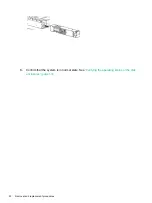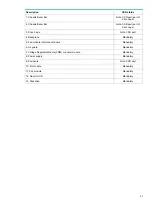
To minimize the likelihood of fatal system errors, take these precautions when removing failed
drives:
•
Do not remove a degraded drive if any other drive in the array is offline (the online LED is
off). In this situation, no other drive in the array can be removed without data loss.
•
Exceptions:
When RAID1+0 is used, drives are mirrored in pairs. Several drives can be in a failed
condition simultaneously (and they can all be replaced simultaneously) without data
loss, as long as no two failed drives belong to the same mirrored pair.
◦
◦
When RAID6 with ADG is used, two drives can fail simultaneously (and be replaced
simultaneously) without data loss.
◦
If the offline drive is a spare, the degraded drive can be replaced.
•
Do not remove a second drive from an array until the first failed or missing drive has been
replaced and the rebuild process is complete. The rebuild is complete when the Online LED
on the front of the drive stops blinking.
Exceptions:
◦
In RAID6 with ADG configurations, any two drives in the array can be replaced
simultaneously.
◦
In RAID1+0 configurations, any drives that are not mirrored to other removed or failed
drives can be simultaneously replaced offline without data loss.
Automatic data recovery (rebuild)
When you replace a disk drive in an array, the controller uses the fault-tolerance information on
the remaining drives in the array to reconstruct the missing data (the data that was originally on
the replaced drive) and write it to the replacement drive. This process is called automatic data
recovery, or rebuild. If fault tolerance is compromised, this data cannot be reconstructed and is
likely to be permanently lost.
Time required for a rebuild
The time required for a rebuild varies considerably, depending on several factors:
•
The priority that the rebuild is given over normal I/O operations (you can change the priority
setting by using ACU).
•
The amount of I/O activity during the rebuild operation.
•
The rotational speed of the disk drives.
•
The availability of drive cache.
•
The model and age of the drives.
•
The amount of unused capacity on the drives.
•
The number of drives in the array (for RAID5 and RAID6 with ADG).
Allow approximately five minutes per gigabyte without any I/O activity during the rebuild process.
This figure is conservative, and newer drive models usually require less time to rebuild.
34
Troubleshooting
Содержание D3600
Страница 8: ...8 Removal and replacement procedures ...
Страница 40: ...4 Component identification 40 Component identification ...














































